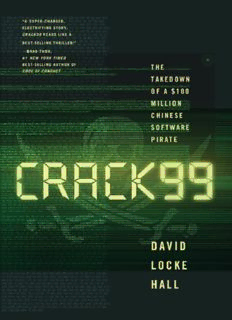
CRACK99 : the takedown of a $100 million Chinese software pirate PDF
Preview CRACK99 : the takedown of a $100 million Chinese software pirate
For my family There is a tide in the affairs of men, Which taken at the flood, leads on to fortune. Omitted, all the voyage of their life is bound in shallows and in miseries. On such a full sea are we now afloat. And we must take the current when it serves, or lose our ventures. —WILLIAM SHAKESPEARE, Julius Caesar, Act 4, Scene 3 No maze all is surprised True deal —XIANG LI www.crack99.com Contents Introduction 1 PERFECT SURE 2 FAST FOOD 3 DISCORDANT NOTE 4 HACKER, CRACKER, SATELLITE TRACKER 5 THAT GIANT SUCKING SOUND 6 THE LAST WAR 7 THE NEXT WAR 8 ONWARD THROUGH THE FOG 9 PLEASANT SURPRISES 10 UNPLEASANT SURPRISES 11 DEAD OR ALIVE 12 THE AMERICANS 13 SLAYING THE DRAGON Acknowledgments Notes Introduction THE DAY AFTER TOMORROW. The Chinese BZK-005 drone executes a slow leftward turn during its routine patrol of the airspace above a string of uninhabited islands in the East China Sea, northeast of Taiwan. The Chinese call them the Diaoyu Islands. The Japanese do not; they call them the Senkaku Islands, illustrating an important point: when it comes to this territory, the Chinese and the Japanese don’t agree on anything. Each country claims ownership, and asserts exclusive sovereignty, no doubt because of the islands’ rumored oil and gas reserves, which have yet to be exploited. The BZK-005 is a long-range unmanned aerial vehicle used in multiple mission sets, including surveillance. When the data link from the BZK-005 to the People’s Liberation Army base on the Chinese mainland fails, no one gets excited; this has happened before, and it will be corrected shortly. This time, however, things are different. Although a squad of technicians swarms into the control room, no one can identify a problem with the data link. It has simply ceased to exist. There is a reason for this: the BZK-005 has ceased to exist. This is what happens when a Chinese BZK-005 is hit by a Sidewinder from a Japanese F-15 fighter. People’s Liberation Army Air Force J-16 fighters launch in response and quickly engage with the Japanese F-15s. If there were a way to watch this from a safe distance, it would look something like an air show—only deadly. The dogfighting is intense, littering the East China Sea with burning aircraft and burning airmen. It lasts as long as the fuel does, ending in a draw. The USS George Washington, CVN 73, and her battle group are on patrol in the Philippine Sea. The carrier receives a flash message directing her northwest toward the disputed island chain. Two F-18 Hornets launch as aviators fill the ready room. Awaiting the intel brief, they mill about speculating on the situation and spreading the latest scuttlebutt. The room smells of burnt coffee and aviation fuel. The Chinese government issues a stern warning to the United States: stay out of it, or suffer the consequences. The threat is ignored, and the George Washington continues steaming northwest. Chinese J-16 fighters intercept her and are escorted out of the operating area by U.S. Navy F-18s. All is well until a salvo of Chinese antisatellite missiles is launched against the U.S. Navy’s Fleet Satellite Communications System, isolating the George Washington. “WAR!” scream the headlines. This would be a bad day by any measure. But it would be particularly galling to learn that the technology employed by the Chinese during this bad day—from the drones to the antisatellite missiles to the fighter radar—was produced in the United States, that the ability of the Chinese to neutralize the U.S. Navy was enabled by the crown jewels of U.S. enterprise stolen by Chinese cybercriminals. The United States is the victim of the greatest transfer of wealth in history. Digital thieves overseas—particularly in China—are systematically stealing U.S. intellectual property, largely without adverse consequences. The value of the information and technology being stolen each year is staggering: hundreds of billions of dollars. Xiang Li was part of this Chinese cybercrime collective and the most prolific Chinese cyber pirate ever caught. From his bastion in Chengdu, China, he operated CRACK99, a website that from 2008 until the time of his arrest in 2011 sold powerful advanced industrial-grade software, the access controls to which had been circumvented—or cracked. The stolen software was worth more than $100 million and covered a lot of technological ground: aerospace and aviation simulation and design, communications systems design, electromagnetic simulation, explosive simulation, intelligence analysis, precision tooling, oil field management, and manufacturing plant design. Cyber pirates like Xiang Li complement the Chinese government’s national strategy to steal U.S. technology. One of the thousands of software titles for sale on CRACK99 was Satellite Tool Kit (STK) 8.0, designed by Analytical Graphics Incorporated to enable the U.S. military and aerospace industry to simulate missile launches and flight trajectories—and to track objects in flight, such as missiles, aircraft (manned and unmanned), and satellites. Moreover, Chinese hackers have reportedly stolen radar software for the $1.4 trillion F-35 stealth joint strike fighter, a fifth-generation tactical fighter still in the testing phase, employing the most advanced U.S. stealth technology. These thefts call into question the ability of the F-35 to remain stealthy in a future conflict with China. Chinese hackers have also reportedly stolen software relating to other military platforms, such as the Global Hawk high-resolution surveillance drone, the UH-60 Black Hawk helicopter, and missile defense systems, including Patriot, Aegis, and Terminal High Altitude Area Defense (THAAD). Some of these digital crimes are sponsored directly by the Chinese government; others— like Xiang Li’s—are motivated by money. Either way, the Chinese are stealing U.S. technology to their strategic advantage, shifting the balance of power away from the United States. from the United States. The potential consequences are epic. So what is the U.S. government doing about it? CRACK99
Description: